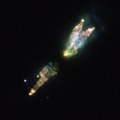Bestand:Westbrook Nebula.tif
Uiterlijk

Afmetingen van deze voorvertoning van het type JPG van dit TIF-bestand: 600 × 600 pixels Andere resoluties: 240 × 240 pixels | 480 × 480 pixels | 1.000 × 1.000 pixels.
Oorspronkelijk bestand (1.000 × 1.000 pixels, bestandsgrootte: 1,8 MB, MIME-type: image/tiff)
Bestandsgeschiedenis
Klik op een datum/tijd om het bestand te zien zoals het destijds was.
| Datum/tijd | Miniatuur | Afmetingen | Gebruiker | Opmerking | |
|---|---|---|---|---|---|
| huidige versie | 9 mrt 2011 14:44 |  | 1.000 × 1.000 (1,8 MB) | Jmencisom | {{Information |Description ={{en|1=The strange and irregular bundle of jets and clouds in this curious image from the NASA/ESA Hubble Space Telescope is the result of a burst of activity late in the life of a star. As its core runs out of nuclear fuel, |
Bestandsgebruik
Dit bestand wordt op de volgende pagina gebruikt:
Globaal bestandsgebruik
De volgende andere wiki's gebruiken dit bestand:
- Gebruikt op ar.wikipedia.org
- Gebruikt op arz.wikipedia.org
- Gebruikt op de.wikipedia.org
- Gebruikt op en.wikipedia.org
- Gebruikt op en.wikiversity.org
- Gebruikt op fa.wikipedia.org
- Gebruikt op fr.wikipedia.org
- Gebruikt op it.wikipedia.org
- Gebruikt op ja.wikipedia.org
- Gebruikt op mk.wikipedia.org
- Gebruikt op pl.wikipedia.org
- Gebruikt op ru.wikipedia.org
- Gebruikt op sk.wikipedia.org
- Gebruikt op tr.wikipedia.org
- Gebruikt op uk.wikipedia.org
- Gebruikt op vi.wikipedia.org
- Gebruikt op www.wikidata.org
- Gebruikt op zh.wikipedia.org

